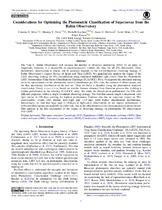| dc.contributor.author | Alves, Catarina S. | |
| dc.contributor.author | Peiris, Hiranya V. | |
| dc.contributor.author | Lochner, Michelle | |
| dc.date.accessioned | 2022-02-04T10:04:15Z | |
| dc.date.available | 2022-02-04T10:04:15Z | |
| dc.date.issued | 2022 | |
| dc.identifier.citation | Alves, C. S. et al. (2022). Considerations for optimizing the photometric classification of supernovae from the Rubin observatory. Astrophysical Journal Supplement, 258(2). https://doi.org/10.3847/1538-4365/ac3479 | en_US |
| dc.identifier.issn | 1538-4365 | |
| dc.identifier.uri | https://doi.org/10.3847/1538-4365/ac3479 | |
| dc.identifier.uri | http://hdl.handle.net/10566/7159 | |
| dc.description.abstract | The Vera C. Rubin Observatory will increase the number of observed supernovae (SNe) by an order of
magnitude; however, it is impossible to spectroscopically confirm the class for all SNe discovered. Thus,
photometric classification is crucial, but its accuracy depends on the not-yet-finalized observing strategy of
Rubin Observatory’s Legacy Survey of Space and Time (LSST). We quantitatively analyze the impact of the
LSST observing strategy on SNe classification using simulated multiband light curves from the Photometric
LSST Astronomical Time-Series Classification Challenge (PLAsTiCC). First, we augment the simulated training
set to be representative of the photometric redshift distribution per SNe class, the cadence of observations, and
the flux uncertainty distribution of the test set. Then we build a classifier using the photometric transient
classification library snmachine, based on wavelet features obtained from Gaussian process fits, yielding a
similar performance to the winning PLAsTiCC entry. We study the classification performance for SNe with
different properties within a single simulated observing strategy. We find that season length is important, with
light curves of 150 days yielding the highest performance. Cadence also has an important impact on SNe
classification; events with median inter-night gap <3.5 days yield higher classification performance.
Interestingly, we find that large gaps (>10 days) in light-curve observations do not impact performance if
sufficient observations are available on either side, due to the effectiveness of the Gaussian process interpolation.
This analysis is the first exploration of the impact of observing strategy on photometric SN classification
with LSST. | en_US |
| dc.language.iso | en | en_US |
| dc.publisher | IOP Publishing | en_US |
| dc.relation.ispartofseries | .; | |
| dc.subject | Cosmology | en_US |
| dc.subject | Astronomy software | en_US |
| dc.subject | Open source software | en_US |
| dc.subject | Light curve classification | en_US |
| dc.subject | Astronomy data analysis | en_US |
| dc.title | Considerations for optimizing the photometric classification of supernovae from the Rubin observatory | en_US |
| dc.type | Article | en_US |

